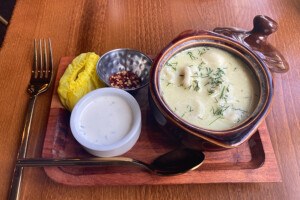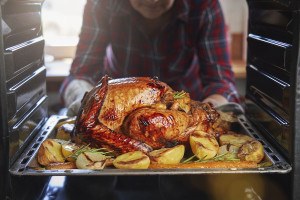Chef Anthony Andiario Isn’t Trying to “Get Back to Normal”
Before the pandemic hit, the West Chester chef’s passion for ingredients, obsession with technique, and insatiable work ethic poised him to become one of the nation’s biggest stars. Now, as restaurants reopen, he’s trying to plan his escape.
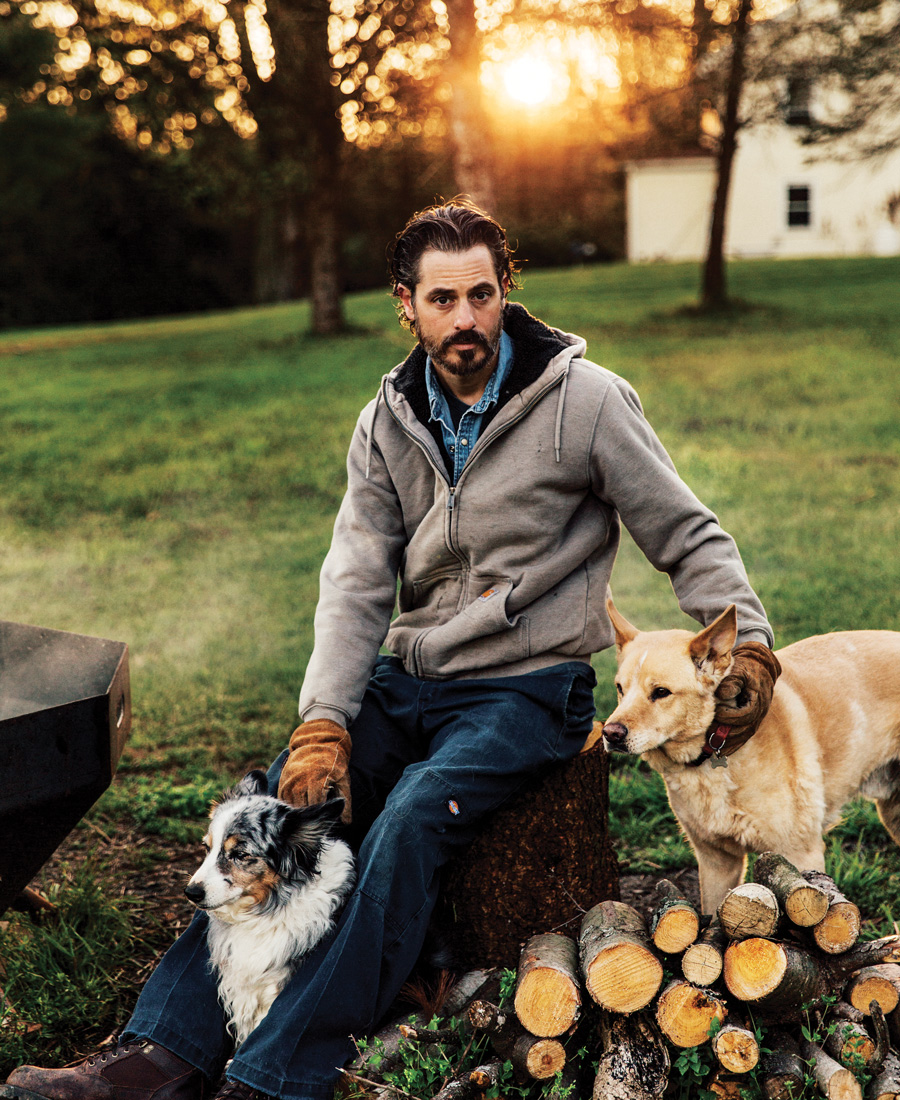
Anthony Andiario in West Chester. Photograph by Bryan Sheffield
1.
There are chefs everyone knows. There are chefs almost no one knows. There are chefs who came so close to stardom that they’re haunted forever by the missed chance, the blown opportunity. And then there’s Anthony Andiario.
He wanted to be a graphic designer.
2.
That was the plan. He was a soccer player first, in high school — good enough that it got him into Penn State. A love of drawing is what led him to graphic design.
“I was always artistic,” he tells me on the phone, because he and I, we’re just talking. Have been talking for quite a while. About food sometimes, but also about school, his family, music, soccer. (I don’t know anything about soccer.)
He was born in Stroudsburg, youngest of four, moved to Wilkes-Barre, grew up well on tree-shaded streets. “I would’ve liked to do design for album covers,” he says. “Travel photography. Not in a studio, but out there, you know? A pencil and a notebook.”
The reason I’m talking to him at all — this chef you maybe don’t even know, or whose name you knew once and then (after this past year and all it has cost) forgot like you’ve forgotten the names of your co-workers or the days of the week — is because he seems to be trying very hard to vanish. To be … less. He spent 15 years in Arizona to become an overnight sensation at his own restaurant, Andiario, in West Chester. He doesn’t care about fame. He doesn’t care about money. He worked harder than he’d ever worked to re-create a perfect moment from his past and then had that all derailed by a virus. Now, he has used this pandemic year to begin building a machine that will allow him to disappear completely.
Anthony Andiario is a man who has been to the brink twice. Who has found success, celebrity, a kind of fulfillment in the purity of his commitment and vision and occasionally seems bewildered by it. He’s a man who dedicates his entire life to cooking dinner and then seems surprised, even a bit annoyed, when people show up to eat. And I’m talking to him (and writing about him) because he’s fascinating. Because almost all people are, if you get them talking about the things they love, but some of them are more fascinating because of the things they want to create. Or destroy.
3.
So imagine for a minute young Tony, 20 years old, sketching album covers in his notebook. Imagine him furious, sitting in front of a computer, having to fulfill an assignment someone else has given him. (“Hard to do if you’re not into making greeting cards,” he says.) He isn’t a cook. He isn’t really anything yet.
But in five years, he’s going to be 2,000 miles away, upending his entire life. In 10, he’s going to be in the kitchen at one of the best restaurants in Phoenix. In 15, he’ll be running the show for one of the best-known chefs on two continents.
Then he’ll be walking away. He’ll be coming home to Pennsylvania with two dogs, a girlfriend, two 600-pound olive trees, and all the cookbooks he owns in a small U-Haul truck that will overheat on the very first incline out of town. He’ll open a restaurant that will, for a brief, bright moment, be the restaurant everyone in the region is talking about. He’ll be invited to the James Beard House to cook a dinner, and while he’s gone, the world will catch fire. For a year, everything will change. So much will end, be lost to plague and catastrophe. And at 41, he’ll be on the phone, watching his dogs run, overlooking his olive trees and the farm he’s trying to build, talking to me and trying to figure out how to upend his life all over again.
4.
There are things that turned Tony into a cook. They’re the same things that can turn anyone into a cook — or the same things that, once you are a cook, you’ll claim led you there. For Tony, it was the smell of tomato leaves in his grandfather’s garden, watching Great Chefs on TV with his father after school, cooking omelets with his mother. He tells me he worked at a Dairy Queen one summer with a bunch of his buddies. That in college, he lived in a house with four other guys, and they cooked sometimes. Cooked a lot, actually. Pots of noodles. Chili. And that’s cooking, sure. But it’s not cooking.
But then there was this girl he was dating at Duquesne. She decided to do a semester abroad in Rome, and Tony thought he’d tag along. He didn’t do it because he wanted to learn to cook or to learn about food (necessarily). He was young. There was a girl. He did it because he didn’t have anything better to do.
5.
“Here’s a story,” Tony says. Not about Rome or his girlfriend or his grandfather. It’s a story of the first night at Andiario. A thing that’s not quite myth but has that kind of shine on it.
It’s March of 2018, and the restaurant — which hasn’t had the easiest of gestations or the smoothest entry into the scene — is brand-new. At the friends-and-family dinner, Tony’s brother stood out in front of the restaurant, inviting strangers in to eat. Now, it’s a couple nights later. The first night of actual service.
“It was super-quiet,” Tony says. The restaurant had no sign, didn’t advertise. He’d just opened. Unlocked the door, then waited to see what happened next.
And the first table that walked in? “They got a bug in their salad. I mean, are you fucking kidding me? First table. First course. And I’m ready to throw my hands up. I’m just like, ‘Shut it down. Let’s go home.’”
He’s someone for whom hitting the big red button and blowing everything up is always an option.
Tony laughs. At the ridiculousness of it, sure. But also because I don’t think he’s entirely kidding. He has walked away from great jobs, profitable opportunities. He cooks a new menu every week, sometimes every day, and rarely repeats himself. When a dish becomes too popular, he pulls it off the menu. When the last order of something goes across the pass, he knows that’s the end of it. He’s someone for whom hitting the big red button and blowing everything up is always an option.
I ask him what happened next, and he says, “They thought the menu was weird. They didn’t like it. They gave us a bad review. And I mean, I get it. They got a bug in their salad. That’s not good.”
“No.”
“Still,” he says, “that was a good way to set the tone for how things were going to go at the beginning.”
6.
Tony says he decided to become a chef on the flight back from Rome. Or decided that he wanted to cook. Or, maybe most accurately, that he wanted to train his focus on food.
After that, his path became a line between there and here — jagged, but traceable. He spends a year in Pittsburgh, haunting grocery stores. He would make soup and just sit there, staring at the pot for hours, adding a little vinegar to see what it did, a little salt, a little cream.
“That’s where I learned seasoning,” he says. “Just trying. Just learning.” He wasn’t in school anymore, didn’t have a job. Just the soup. Food Network on the TV.
He does that for a year.
His girlfriend graduates, gets a job in Phoenix, and again, he follows her. Does the same thing in Arizona with the grocery stores and the soup pot. The girlfriend doesn’t last, but his obsession does. He starts playing around with pasta — making his own dough, rolling and cutting shapes by hand. For hours every day, it’s just him and the pasta, eaten straight out of the water as he studies texture, consistency, what happens with a little more flour, a little more egg.
In the Phoenix area, there were two big culinary schools. The Scottsdale Culinary Institute (now Le Cordon Bleu College of Culinary Arts Scottsdale) was the fancy one, housed at a former country club overlooking Camelback Mountain. The other was the Arizona Culinary Institute, where the tallest thing to see in any direction was the transmission towers running along Shea Boulevard. ACI was scrappy. It cost half as much and turned out trained cooks in eight months.
Tony went to ACI. He was 25 years old.
7.
Tony reads all the textbooks before classes even start. In class, he knows how to use a knife. He knows how to, you know, turn the oven on. This sets him apart.
One of the instructors says he knows a guy and sends Tony to Michael DeMaria, whose restaurant, Michael’s at the Citadel, is a massive, popular New American operation famous for chewing up young cooks and spitting them out to go make brunch, sell used cars, or whatever it is that coulda-beens do in Arizona.
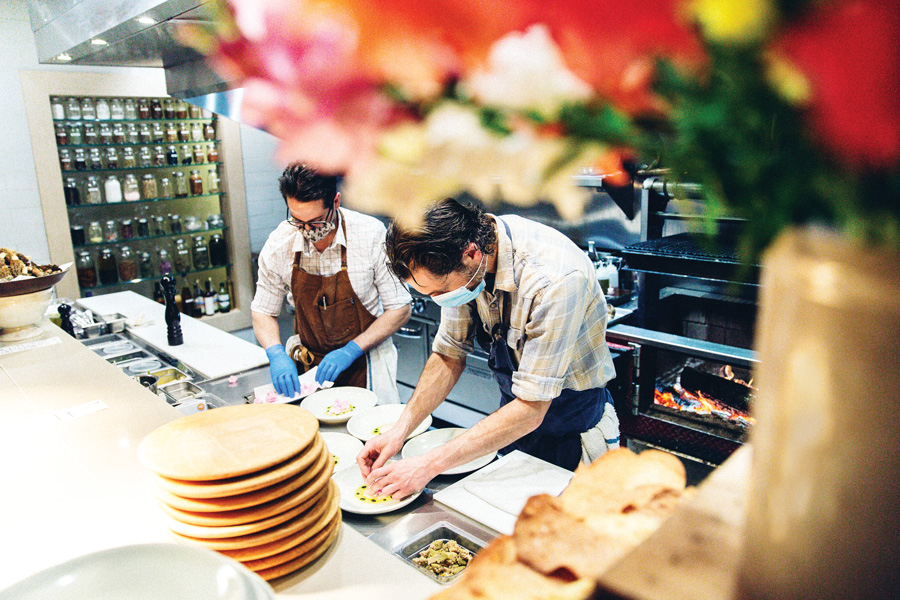
Anthony Andiario (right) in the kitchen at his namesake restaurant. Photograph by Bryan Sheffield
Michael’s is brutal. DeMaria tells Tony to his face that he’s too old, too green. But Tony hangs on, rises, gets hired on at $5.15 an hour — his first actual cooking job. When he leaves two years later, he’s running the line.
Next, he follows Greg LaPrad (another chef, a few years further along in his career) to Quiessence in Phoenix. Greg had watched Tony’s back and kept him going during his worst, hardest months at Michael’s. They’d become friends.
And Quiessence is perfect. It has its own nine-acre farm. A great kitchen. But the menu is a mess, Tony says: “It’s 2006, and this place is running with something that’s like a catering company’s wedding menu from the ’90s.” Greg wants Tony to drop everything and come take over the pasta program.
Tony would do other things in Phoenix. He’d work for Kevin Binkley and organize kitchens for Chris Bianco — maybe the most famous American pizzaiolo ever to walk the earth. He’d buy a house, plant a garden with 17 fruit trees. He would meet his girlfriend and partner, Maria van Schaijik, at one of Bianco’s restaurants and get called “a rock star-in-waiting” by Dominic Armato, the Arizona Republic’s restaurant critic.
But what matters most here is Quiessence. Tony would spend the next eight years in that kitchen.
He would spend every day after trying to re-create it wherever he was.
8.
There’s something you have to understand about Andiario before we go any further. On its best nights, it was absolute magic.
When I reviewed Andiario, I wrote that watching Tony work was like watching an NBA all-star play a pickup game in a parking lot. To taste his food was to taste the purity of someone cooking without ego, purely for the love of the game.
I had no idea that Andiario was about to explode. That Tony was about to become one of the best-known names in the region. No one did. And even though it would all seem like it came out of nowhere, it really didn’t, because Andiario was Tony’s attempt at recapturing the feeling of Quiessence. It was him recalling a moment when he’d had everything a young chef could dream of — freedom, access to product, someone else to worry about the money and his best friend cooking beside him — and trying to capture that again under different circumstances. I didn’t understand then how Quiessence had become his life, consumed his every hour. How he and Greg took huge risks there, working with little oversight from the owners, cooking the kinds of thoughtful, local, seasonal menus that no one in Arizona had seen before, inventing cuisine on the fly, and assembling systems that allowed them to cook exactly what they wanted, exactly how they wanted.
(Later, Maria would confirm all this for me, saying that while Tony’s food changed a lot over the years — becoming simpler, more personal, more comforting — the experience of working at Quiessence was absolutely formative. “Being in that headspace,” she’d tell me, “where he’s on his own, doing things that no one else was doing, with no one watching him and no one telling him what he should or shouldn’t do? That was what he was chasing.”)
What I’m saying is, Tony had been here once before. Quiessence was one of the best restaurants in Phoenix. It was lauded, beloved. The phone never stopped ringing. People kept wanting more and more from it — from him and from Greg — until they just couldn’t give anything else. When the ownership changed and Greg announced he was leaving, Tony decided he was done, too: “I just felt like it was time.”
In West Chester, it was all about to happen again. And there’s Tony in the middle of it, risking everything, staking it all on every plate of pasta that goes across the pass.
There’s Tony, in the middle of it, head down, staring into a pot of boiling water and wondering what happens next.
9.
On a warm morning in April, almost three years gone from those early days of Andiario, I ask Tony about it — what it was like just before everything blew up.
He thinks about it for a minute, then says what’s maybe the truest thing I’ve ever heard from a chef.
“I’m not trying to run a real restaurant,” he says. “I’m just trying to cook. And the restaurant gets in the way.”
To illustrate his point, he tells me the Risotto Story.
It goes like this: While working at Quiessence, Tony decided he wanted to put risotto on the menu. Not just any risotto, though. He wanted to do risotto à la minute — to start it in the pan only when it was ordered on the floor.
This was stupid for a number of reasons. Risotto is delicate. Fussy. Vengeful. It takes a long time to cook — 22 minutes, give or take, during which it requires constant babying and slavish attention, being gently stirred and fed repeated sips of stock. To put risotto of any variety on a menu is proof of naivete. Professional kitchens will par-cook, batch-cook, take shortcuts, and the result (always) is an inferior risotto. Never as good as one cooked right, babied properly.
Tony knew all of this. He knew it was stupid. But he did it anyway, because there was this legend about another chef at Michael’s who’d done this: cooked risotto to order, served it to an adoring, grateful public. And if that guy could do it, Tony thought, he’d be damned if he couldn’t do it, too.
So he does. Puts it on the menu, cooks it just as described — a sip and a stir. Unsurprisingly, the risotto he’s putting out is the best risotto anyone has ever had. Also unsurprisingly, people start talking about it. People start coming in specifically for the risotto.
And this was where the system fell apart. Because making risotto that way isn’t scalable. You could do one, maybe two. Any more than that, and the wheels come off.
Tony could have backed down. He could have taken all the shortcuts that pro kitchens do, but that would have defeated the purpose of making risotto right in the first place. It would have meant serving something that was less than what he wanted to serve. So what did he do?
He took it off the menu. Completely. When given the option of making bank on a compromised product or making nothing on nothing, he chose nothing.
“Fuck it,” saith Anthony. “There are other ways to make money.”
Wait, though. There’s one more piece to this story.
Years later, Tony would run into a guy who was there at Michael’s — a witness to the original à la minute risotto — and he’d ask him: How did you guys do it? How did you make it work?
At which point, this guy starts laughing. He tells Tony that the other chef had done it one time. That he’d made one order of risotto that way because it was the end of the night and he’d run out of the pre-cooked stuff without 86-ing it.
Because seriously, who’s gonna put a fucking à la minute risotto on the menu?
10.
Everything about Tony after Quiessence became a version of the Risotto Story. Everything became about control and trying to re-create something that has already become a myth. Not in any mean or dictatorial way, but thoughtfully. Almost sweetly. In the way that some men of a certain age collect baseball cards and assemble the teams they knew as children.
“I was trying to leave Phoenix for four or five years at that point,” he tells me. “I always knew where I was going to go.”
He doesn’t mean West Chester or Pennsylvania or even East when he says that. He means his own kitchen, like it was a destination.
11.
On the phone, Tony and I talk about what came next. How Maria (who, like Tony, had come late to restaurants — though in her case, it was while studying statistics at ASU) left Phoenix while he was still working for Chris Bianco and how she’d walk through spaces with her phone while Tony watched on Facetime from the kitchen at Tratto, Bianco’s award-winning Italian restaurant, 2,000 miles away. How she did the market analysis and put together business plans. Her parents lived in West Chester; his, in Wilkes-Barre. When Tony flew in, he went to meet farmers. He walked through a bunch of fields before he ever stepped into the former consignment shop that would become Andiario.
They left Phoenix with their house still on the market, a U-Haul packed to the ceiling with all those cookbooks, two olive trees, two dogs and no money. The truck died a half-hour outside of Phoenix. They got it repaired, and the next day, the car-trailer they were towing slipped off the hitch as they were pulling out of their motel. The apartment they’d planned to move into in West Chester turned out to be a scam — an actual house, but with someone else already living in it — and they arrived homeless, spent months couch-surfing, bouncing between his parents’ place and hers.
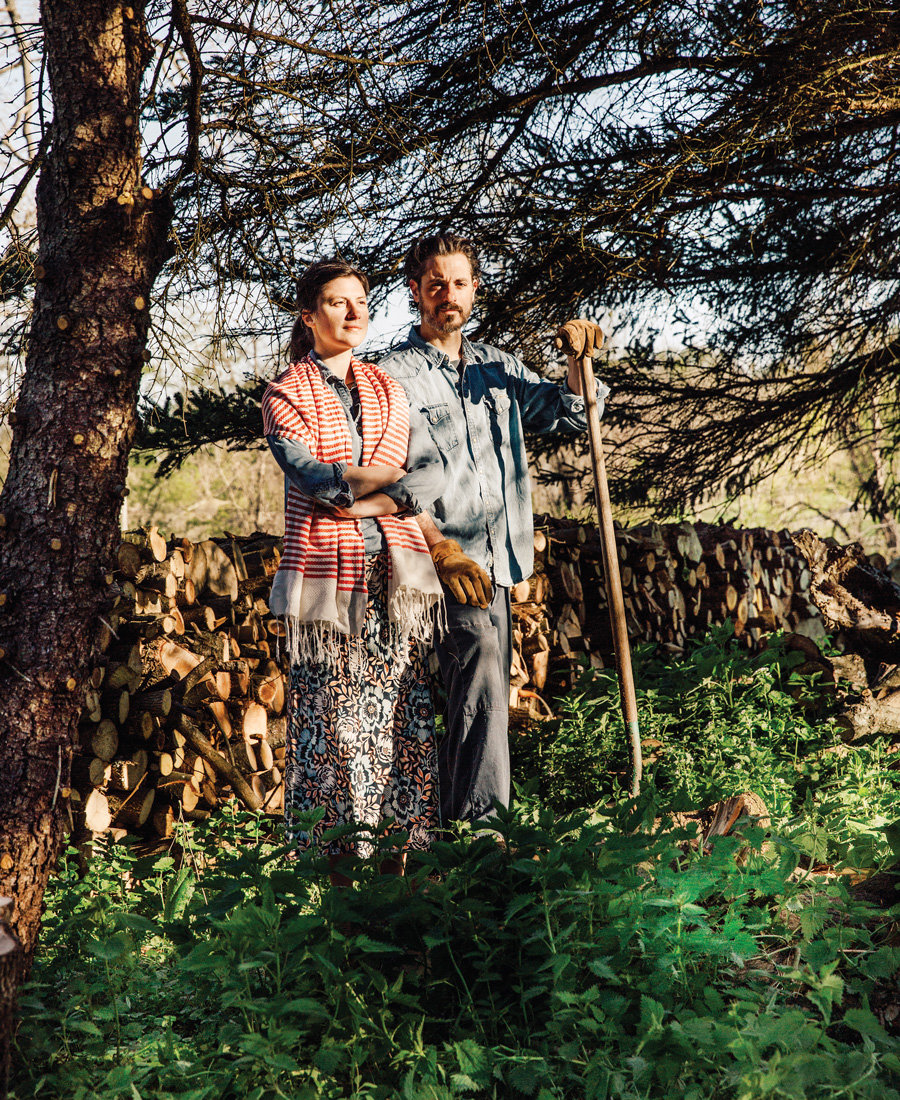
Anthony Andiario and Maria van Schaijik on their new farm in West Chester.

Anthony Andiario on his West Chester farm. Photograph by Bryan Sheffield
There were problems with the contractors, problems with staffing. They didn’t know anyone in town, had spent every dime they had, borrowed money from their families, spent all that, then maxed out their credit cards. They were broke, frustrated. Then came the opening, the bug in the salad. That first night, they did 14 covers, total. The first week? Not many more.
“The money was terrifying,” Maria tells me. And she would know, because she was the one who was paying attention. Tony wasn’t. Couldn’t. “It can cripple you,” he says, thinking about the money, the books, the reservations.
So Maria swallowed it all. “I just decided to bury my feelings. I didn’t even tell him, because it wasn’t the kind of thing where one good night or one good week of reservations was going to fix it. It was so much worse than that.”
Tony tells me he wasn’t worried. He says that after Quiessence, after Chris Bianco and Tratto, he felt like he understood something. Like he’d cracked the formula for making a restaurant successful. He saw Andiario as an East Coast Chez Panisse. He would serve only Pennsylvania product. He wouldn’t put a roast chicken on the menu as a safety dish, just to make people feel comfortable. Instead, he does veal carpaccio with pickled mushrooms and crumbles of blue cheese; braised pork shoulder with summer corn and peaches.
“My food isn’t weird. It’s not weird shit. It’s based on something you can relate to, you know? I knew how my food had been received in the past, so I was confident.” He pauses. “Stupidly confident, maybe.” Pauses again. “And hey, I’m not saying what I’m saying is correct. I’m just saying where I was. What I was thinking at the time. I knew what we had to do to not go under. And if we can’t get that many people through the door, I don’t want to do this.”
Because if you’re not going to do it right, why cook the risotto at all?
And look, if this were a different story, all of that could easily have become Andiario’s epitaph. But it didn’t. Fourteen covers became 20, became 30, became two full turns plus a little.
Craig LaBan gave Andiario three bells in August of 2018. My review came out in September. Bon Appétit wrote about Tony. He was interviewed by newspapers and magazines and had 60,000 followers on Instagram, where he pretty much just posted videos of himself hand-making esoteric pastas. Suddenly, there’s not enough tables. The wait for a prime-time reservation stretches to three months. They can do two full turns on a Friday now. If they have the crew, three on the weekends. Everyone running from morning till night.
And to Tony, something about this is starting to feel very familiar. When we talk about it, he says, mostly to himself, “Can you do it? Yeah. Everyone does. But do you want to?”
12.
For a moment, you’re a monolith. You’re the thing — the hottest ticket, the biggest deal. No one sees the journey that got you there. Often, no one sees what comes after.
In the moment, everything is lights and loud noises. You’re the center of a furious storm. Everything is beautiful and terrible, both at the same time.
“For years, I’ve been prepping,” Tony says. “Writing menus, turning on the lights, stepping up to the stove and then cooking something for the first time. There’s no recipe-testing here. This dish will never be cooked again in this way. Nothing is ever the same. I get up in the morning. If I’m not at work by 8 a.m., I’m running behind. At 11:30 at night, I’m scrubbing the floors with the crew. Nothing changes. If you thought about it, you might do something different. But where do you have time to think?”
13.
In the middle of 2019, Tony and Maria very quietly took over a bakery — La Baguette Magique, about a block away in West Chester. The owner, Catherine Seisson, was diagnosed with cancer and wanted to go home to France for treatment. Maria was friendly with her and made an offer to buy. She and Tony had been looking at building out Andiario anyway; this was easier (and cheaper). When the deal was done, Maria began splitting her time between the bakery and the restaurant, starting work at 5 a.m., making pastries (impressive for someone who wasn’t a pâtissière), coming home to nap, then working nights at Andiario as hostess. Tony was in the kitchen all day and all night. It was the only way to keep up. Soon after, he was invited to cook at the James Beard House in New York.
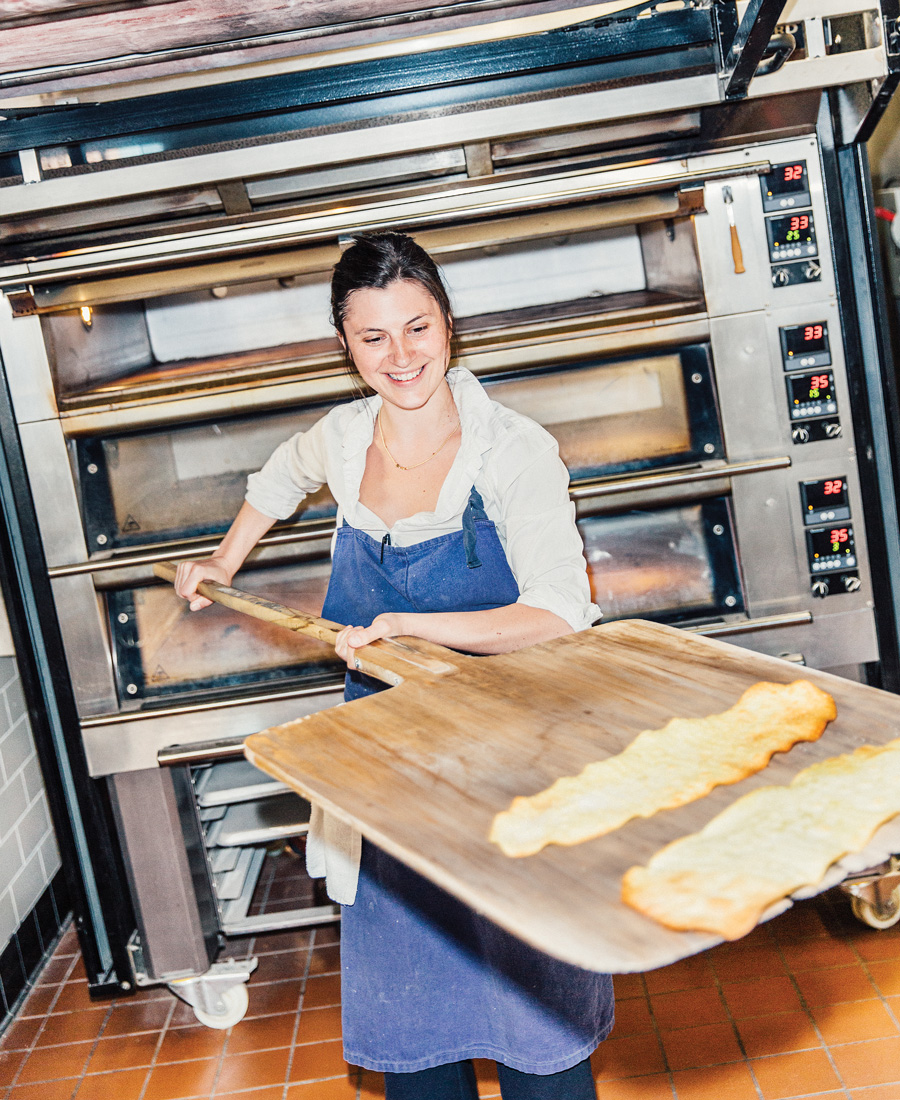
Maria van Schaijik baking bread at La Baguette Magique. Photograph by Bryan Sheffield
Maria comes up to Tony after work one night. She’s happy. Everything they’ve been through to get to where they are, and now it looks like things are going to work out. “What else could possibly go wrong?” she says.
The James Beard dinner is on January 30, 2020.
14.
The pandemic changed everything. No one knew what to do. No one knew what was going to happen. Tony bought a lot of product — three, four times what he normally would. He stocked up on to-go containers. When the shutdown order came, Andiario closed for one day, then pivoted immediately to takeout.
“It was all about, ‘How can we feed people? How can we help the community?’” he says. “We didn’t know anything.”
He did what he’s always done. The only thing he could do. He cooked. Five days a week, he’d do a prix-fixe menu: $30 for an app, an entrée, a dessert, a hunk of fresh bread. He would put it up on Facebook, and people would start calling to secure a window of time to pick up to-go boxes of pâté de campagne with giardiniera, ricotta cappelletti with asparagus and morel mushrooms, strawberry-rhubarb crostata. In the beginning, they’d all stand around, masked and distanced, while Maria poured sips of champagne for everyone like it was Paris before the Fall. Later, they’d have to shut the doors and deliver bags to cars at the curb. Maria says some people kept the handwritten menus they’d slip in the bags — mementos of their own pandemic year.
“It made everything small,” she says. For months, they were cooking mostly for their neighbors, locals. Often, it was for the same people every week.
Tony completely changed the layout of the restaurant. He turned the entire place into an assembly line built for feeding as many people as he could. He felt like if he could keep the community going, they would keep him going. And if they could keep him going, he could keep the farmers going and the producers going.
What’s more, he found that he liked cooking this way. Wearing a t-shirt. Blasting music. One day, it would be smoked duck with preserved cherries and mustard greens; the next, braised short rib with asparagus au gratin. “It doesn’t have to look good. It just has to taste delicious and be comforting. It was like just cooking again.”
The pandemic took away a lot of things. One thing it gave? Time. Time to think, to plan, to look at the future.
After that, it was outdoor seating — glasses of wine and a cicchetti menu. Small plates. Guinea hen and pork terrine, scallop crudo with strawberries and elderflower. When the sun was out, every seat would be filled. The bakery was doing better than it had been before the pandemic, even.
When the weather turned, there were holiday specials for takeout. Limited indoor seating when they could. In January, they took a long break, then started back with service at Andiario every other week, Fridays and Saturdays only.
The pandemic took away a lot of things. One thing it gave? Time. Time to think, to plan, to look at the future. Tony knew how he’d gotten to where he was in January of 2020. What he didn’t know anymore was whether or not he wanted to stay there.
“The opportunity of this pandemic,” he says, then stops. “I mean, I don’t think I should call it that. But the chance it gave us to kind of start over? It would be stupid not to take advantage of that.”
For months, he and Maria had been looking at farms in the area. They wanted some land of their own to grow on. There was a place in East Bradford they liked. Five acres, a house, just 10 minutes from the restaurant. It was an old Christmas tree farm, badly overgrown but workable. Tony was imagining an orchard, a big garden plot, a flock of chickens so he’d always have eggs for his pasta. He wanted that connection to the land. The terroir of a true Pennsylvanian cuisine.
So they signed the papers. Most of the conversations we have, he’s looking out at the first 6,000 square feet he has under cultivation, the first cover crop already going in.
15.
On a Friday night in April, Tony calls me after the service is done. At midnight, we sit and talk about systems and processes, chefs and menus. Listening to him, I can hear the ideas forming — the notion of what Andiario would be (or could be) when the world and the industry right themselves.
He’s just started cooking three nights a week — Thursdays, Fridays and Saturdays. Seatings of 22, which he thinks is the right number for the space. Better than the 38 he had pre-pandemic. He’s running a prix-fixe menu now that customers don’t see until they arrive. They have to trust him. He likes it because it gives him more control than à la carte and saves him the trouble of constantly taking things off the menu when they get too popular. He puts reservations up, and they’re gone in minutes.
He says, “I’m a different cook now than I was a year ago, and that’s good. That’s fine. The pandemic … I think we’re going to see a trend. Chefs, it’s given them time to reflect. And some of us, most of us, have probably never had that before.”
He thinks a lot about the farm. With the bakery making money, some of the pressure is taken off Andiario. Mostly, what he talks about is doing less. Being less. “I’m trying to limit, to cut off numbers I could do. I’m looking at what’s the minimum. Which is stupid. I know that. But I always want to do less there.” He takes a breath and sighs. “What we need is to be able to shut down.”
Not for good, but for a month. A month in winter, a month in summer. He wants time to travel, to recharge, to work on the farm and get his hands in the soil and play with his dogs.
I ask him if this past year has been about redesigning systems at the restaurant to make it easier to step away, or about redesigning his life as a human. He barely has to think about it before answering.
“I guess I don’t really feel like they’re separate. If you go into this profession, you’re dedicating your life to it. You’re gonna make a lot of sacrifices. You’re going to lose a lot.” But if you can figure out the system — if you can see the way the vinegar affects the soup and the eggs affect the pasta, how the seasons change the ingredients and the ingredients change the menu, how the number of seats changes the rhythm on the floor and how certain opportunities can change your entire life?
If you can step back for a minute and see all that, you can design a machine that allows you to step away. That will run even when you’re not looking. When you’re not even there.
“And then,” he says, “everybody wins.”
Published as “The Disappearing Man” in the June 2021 issue of Philadelphia magazine.
